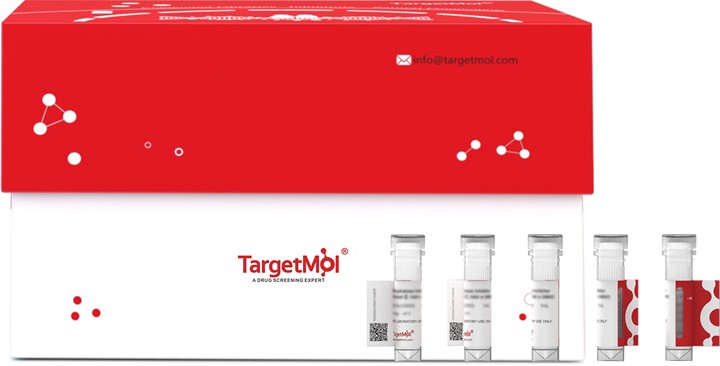 Your shopping cart is currently empty
Your shopping cart is currently empty
Thrombomodulin Protein, Mouse, Recombinant (His)
Thrombomodulin is also known as CD141 antigen and blood dendritic cell antigen 3 (BDCA3), which is encoded by the THBD gene. The deduced amino acid sequence of mouse THBD predicts a signal peptide (aa 1 to 16) and a mature chain (aa 17 to 577) that consists of the following domains: C-type lectin, EGF-like, transmembrane and cytoplasmic. Mouse THBD is corresponding to the extracellular portion of the type I membrane protein. Predominantly synthesized by vascular endothelial cells, THBD inhibits coagulation and fibrinolysis. It functions as a cell surface receptor and an essential cofactor for active thrombin, which in turn activates protein C and thrombinactivatable fibrinolysis inhibitor (TAFI), also known as carboxypeptidase B2 (CPB2). In addition, THBD gene polymorphisims are associated with human disease and THBD plays a role in thrombosis, stroke, arteriosclerosis, and cancer.

Thrombomodulin Protein, Mouse, Recombinant (His)
| Pack Size | Price | USA Warehouse | Global Warehouse | Quantity |
|---|---|---|---|---|
| 5 μg | $112 | 7-10 days | 7-10 days | |
| 10 μg | $183 | 7-10 days | 7-10 days | |
| 20 μg | $292 | 7-10 days | 7-10 days | |
| 50 μg | $545 | 7-10 days | 7-10 days | |
| 100 μg | $813 | 7-10 days | 7-10 days | |
| 200 μg | $1,190 | 7-10 days | 7-10 days | |
| 500 μg | $2,070 | 7-10 days | 7-10 days | |
| 1 mg | $2,970 | 7-10 days | 7-10 days |
Product Information
| Biological Activity | Activity has not been tested. It is theoretically active, but we cannot guarantee it. If you require protein activity, we recommend choosing the eukaryotic expression version first. |
| Description | Thrombomodulin is also known as CD141 antigen and blood dendritic cell antigen 3 (BDCA3), which is encoded by the THBD gene. The deduced amino acid sequence of mouse THBD predicts a signal peptide (aa 1 to 16) and a mature chain (aa 17 to 577) that consists of the following domains: C-type lectin, EGF-like, transmembrane and cytoplasmic. Mouse THBD is corresponding to the extracellular portion of the type I membrane protein. Predominantly synthesized by vascular endothelial cells, THBD inhibits coagulation and fibrinolysis. It functions as a cell surface receptor and an essential cofactor for active thrombin, which in turn activates protein C and thrombinactivatable fibrinolysis inhibitor (TAFI), also known as carboxypeptidase B2 (CPB2). In addition, THBD gene polymorphisims are associated with human disease and THBD plays a role in thrombosis, stroke, arteriosclerosis, and cancer. |
| Species | Mouse |
| Expression System | HEK293 Cells |
| Tag | C-6xHis |
| Accession Number | P15306 |
| Synonyms | TM,Thrombomodulin,Thbd,Fetomodulin,CD141,BDCA-3 |
| Amino Acid | Leu17-Ser517 |
| Construction | Leu17-Ser517 |
| Protein Purity | Greater than 95% as determined by reducing SDS-PAGE. (QC verified) |
| Molecular Weight | 85-90 KDa (reducing condition) |
| Endotoxin | < 0.1 ng/µg (1 EU/µg) as determined by LAL test. |
| Formulation | Supplied as a 0.2 μm filtered solution of 20 mM Tris-HCl, 150 mM NaCl, pH 8.0. |
| Stability & Storage | Lyophilized powders can be stably stored for over 12 months, while liquid products can be stored for 6-12 months at -80°C. For reconstituted protein solutions, the solution can be stored at -20°C to -80°C for at least 3 months. Please avoid multiple freeze-thaw cycles and store products in aliquots. |
| Shipping | Shipping with blue ice. |
| Research Background | Thrombomodulin is also known as CD141 antigen and blood dendritic cell antigen 3 (BDCA3), which is encoded by the THBD gene. The deduced amino acid sequence of mouse THBD predicts a signal peptide (aa 1 to 16) and a mature chain (aa 17 to 577) that consists of the following domains: C-type lectin, EGF-like, transmembrane and cytoplasmic. Mouse THBD is corresponding to the extracellular portion of the type I membrane protein. Predominantly synthesized by vascular endothelial cells, THBD inhibits coagulation and fibrinolysis. It functions as a cell surface receptor and an essential cofactor for active thrombin, which in turn activates protein C and thrombinactivatable fibrinolysis inhibitor (TAFI), also known as carboxypeptidase B2 (CPB2). In addition, THBD gene polymorphisims are associated with human disease and THBD plays a role in thrombosis, stroke, arteriosclerosis, and cancer. |
Dose Conversion
Calculator
Tech Support
| Size | Quantity | Unit Price | Amount | Operation |
|---|

Copyright © 2015-2025 TargetMol Chemicals Inc. All Rights Reserved.



